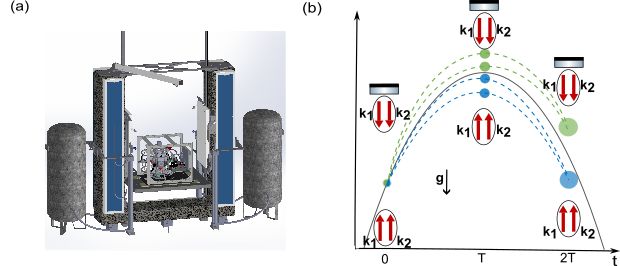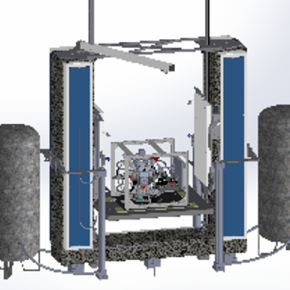An Einstein lift to sharpen up future space-borne quantum sensors
A team has developed a laboratory experiment that is representative of the quantum sensors of the future. Using a unique experimental platform that reproduces zero gravity conditions, they have measured with exceptional precision the acceleration of atoms cooled to a few millionths of a degree above absolute zero.
References :
Atom interferometry in an Einstein Elevator, C. Pelluet, R. Arguel, M. Rabault, V. Jarlaud, C. Métayer, B. Barrett, P. Bouyer, B. Battelier, Nature Communication 16, 4812 - Published: 23 May 2025.
Doi : 10.1038/s41467-025-60042-7
Quantum technologies open up a wide range of prospects for applications ranging from fundamental physics to industrial applications requiring the utmost precision. Quantum sensors represent a real technological breakthrough for the metrology of various physical quantities, such as time, the electric field, the magnetic field and gravitational waves. Among these, quantum inertial sensors represent a singular challenge, as they are based on measurements of gravity, acceleration or rotation, taken on atoms in free fall and cooled to a few millionths of a degree above absolute zero. Unfortunately, their performance remains limited on Earth, where human activity and atmospheric disturbances degrade the accuracy of the measurements. To push back the limits of these sensors, the aim is to eventually deploy them in space, especially as quantum sensors have clearly been identified for future space missions as prime candidates for instrumenting fundamental physics experiments in orbit, or for observing climate change through the dynamics of water masses.
The present research was conducted in the following CNRS laboratory:
Laboratoire Photonique Numérique & Nanosciences (LP2N, CNRS/Institut d'Optique Graduate School/Université de Bordeaux)
The entry ticket for installing these new complex sensors on a satellite is a demanding and costly technological development. That is why research programmes in France, Germany, China and the United States aim to conduct experiments on sounding rockets, free-fall towers, during parabolic flights in the Airbus zero G, or even in orbit around the Earth on the International Space Station (ISS). All these platforms provide relative accessibility and/or a limited duration of microgravity experiments. In this context, a team of French physicists from the Laboratoire Photonique Numérique & Nanosciences (LP2N), supported by CNES, ESA and the European Union, has developed a free-fall experiment in a laboratory that uniquely allows the acceleration of 10 million rubidium atoms cooled to approximately + 0.000001 degrees above absolute zero to be measured using an interferometer installed on a dedicated platform. The ‘free fall’ device is based on Einstein's elevator principle (namely that in a free-fall reference frame, the force of gravity acting on a particle is exactly compensated by the inertial force associated with the device's reference frame, this is referred to as ‘weightlessness’) and creates weightless conditions for nearly half a second every 13 seconds. This innovative equipment, approximately 3 metres high and capable of supporting a payload of 200 kg, was developed by the French company Symétrie, based in Nîmes. This experiment changes the paradigm of access to microgravity and opens up the possibility of exploring the limits of quantum measurement in a free-fall device that is accessible on a daily basis, repeatedly and reproducibly, thus allowing for one hour of microgravity experience per day.

This experiment is an essential tool for the development of a quantum accelerometer for space. This topic represents a major empowerment issue for the European Union, which launched the CARIOQA (Cold Atom Rubidium Interferometer in Orbit for Quantum Accelerometry) mission in 2022. This project, under the technical coordination of CNES and DLR (the French and German space agencies), brings together a European consortium of industrial and academic partners with the aim of demonstrating the operation of this new generation of sensors on a satellite in the early 2030s.
